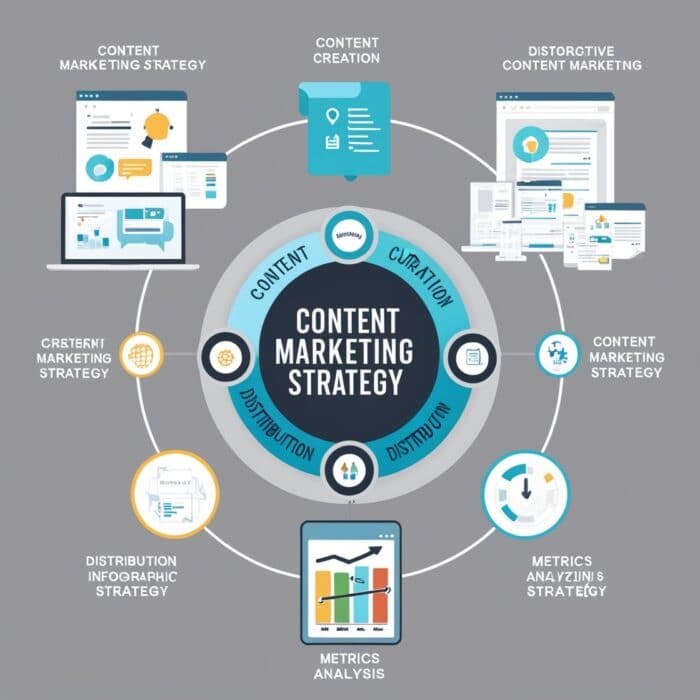
Content marketing 1-1: Content marketing concepts and strategy, Developing a content marketing plan, Using content research to find opportunities
From now on, you will learn content marketing concepts and strategy, how to develop a content marketing plan, and how to use content research to find opportunities
Content marketing concepts and strategy
Content marketing is a type of marketing that involves the creation and sharing of online material that does not explicitly promote a brand, but is intended to stimulate interest in its products or services.
There are several key benefits of content marketing. First, it can help grow awareness of a brand or business. Second, it can increase and improve search engine rankings or SEO. Third, it can generate new business leads, nurture sales prospects, and convert customers. And fourth, it can help build long-term relationships with current and future customers.
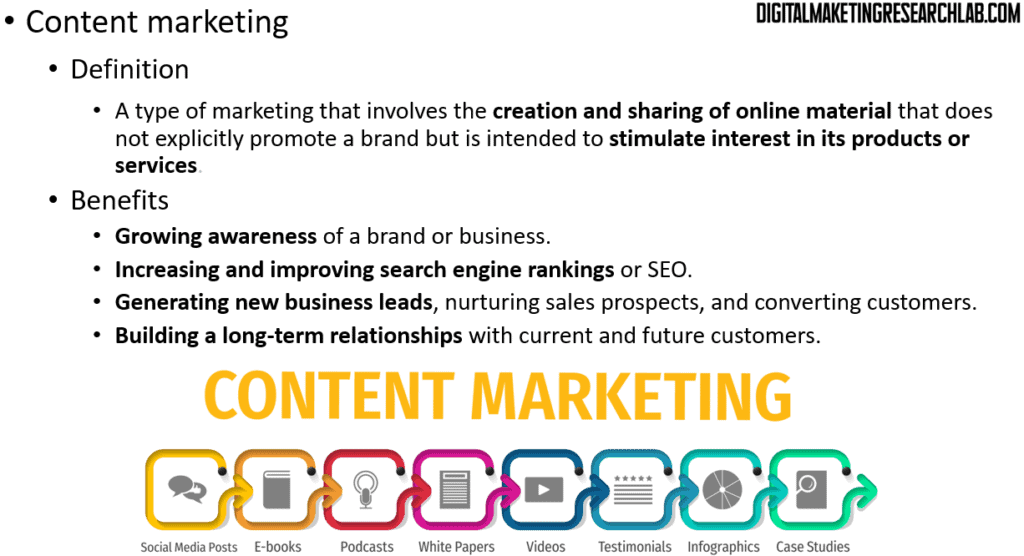
For content to be effective, it needs to have several key qualities. First, it should be relevant to the business objectives. Second, it should address the needs of the target audience by helping to solve their problems. Third, it should present a clear solution that demonstrates how the brand can solve the audience’s issues.
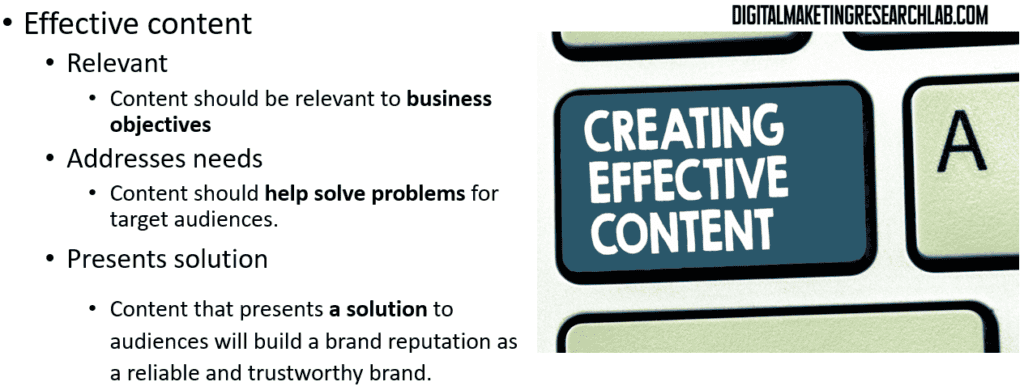
Effective content also needs to be personalized. Content that serves personal purposes and addresses the individual needs of the audience will help build a bond and trust between the brand and its customers.
Additionally, valuable content – content that is useful, educational, or entertaining – is key to converting prospects into customers. This type of content provides genuine value to the audience, beyond just promoting the brand’s products or services.
Lastly, effective content includes a clear call-to-action, or CTA. A strong CTA gives the audience a clear direction on what actions they should take next, potentially leading them to become customers.
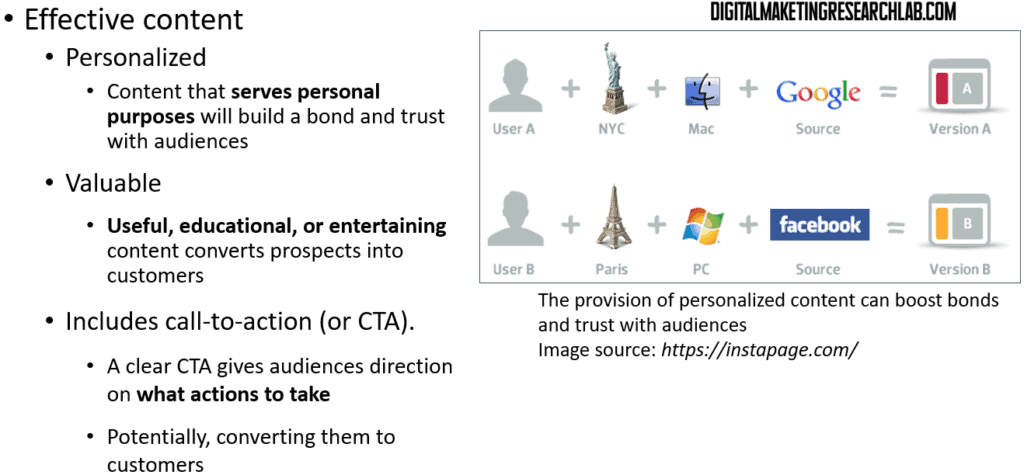
Content can also be categorized as either evergreen or topical. Evergreen content is timeless and can be used at various stages of the buyer’s journey. It typically has a longer lifespan and is more likely to be repurposed into different formats. Topical content, on the other hand, is time-sensitive and linked to current events or trending topics. It has a shorter lifespan and is less likely to be repurposed.
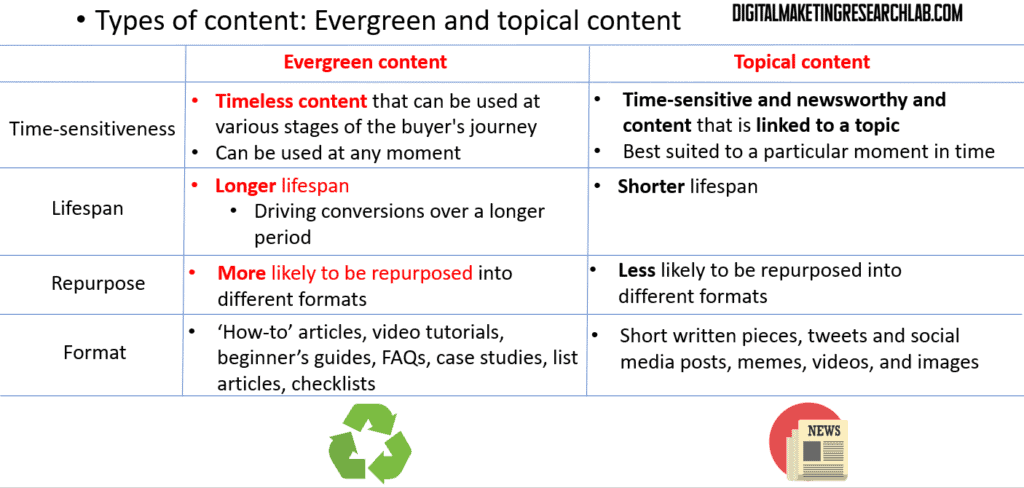
A content marketing strategy is a plan that outlines the content marketing goals and target audience. It serves several key functions, such as providing a roadmap for execution, determining the content the target audience needs, defining content formats and styling, aligning content with business objectives, and optimizing content to adapt to changes in the market.
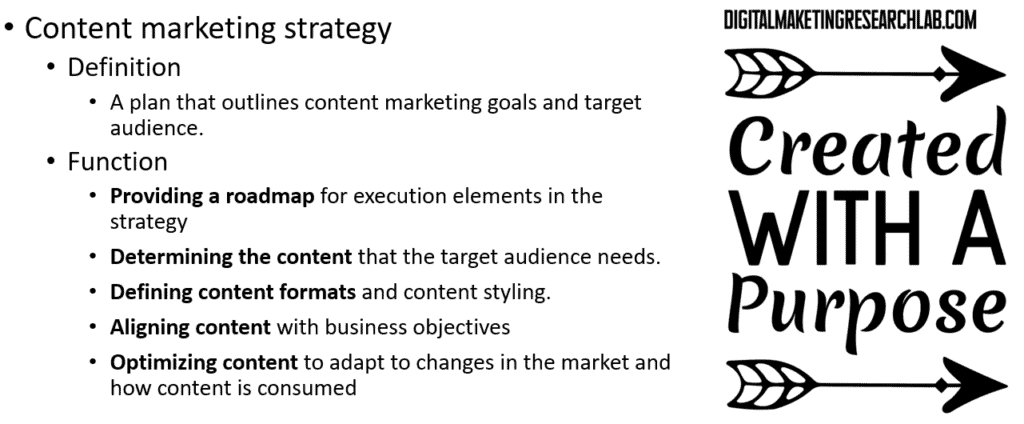
The content strategy aims to communicate the overall brand or campaign message across all creative assets and marketing channels. This ensures consistency in how the brand’s messaging and positioning is delivered.
The creative strategy, on the other hand, sets out the specific messaging and tone to be used across all creative assets and content pieces. This helps to establish a cohesive brand personality and voice throughout the marketing materials.
By aligning both the content strategy and creative strategy, the content marketing plan can effectively convey the brand’s story and value proposition to the target audience in an engaging and memorable way across multiple touchpoints.
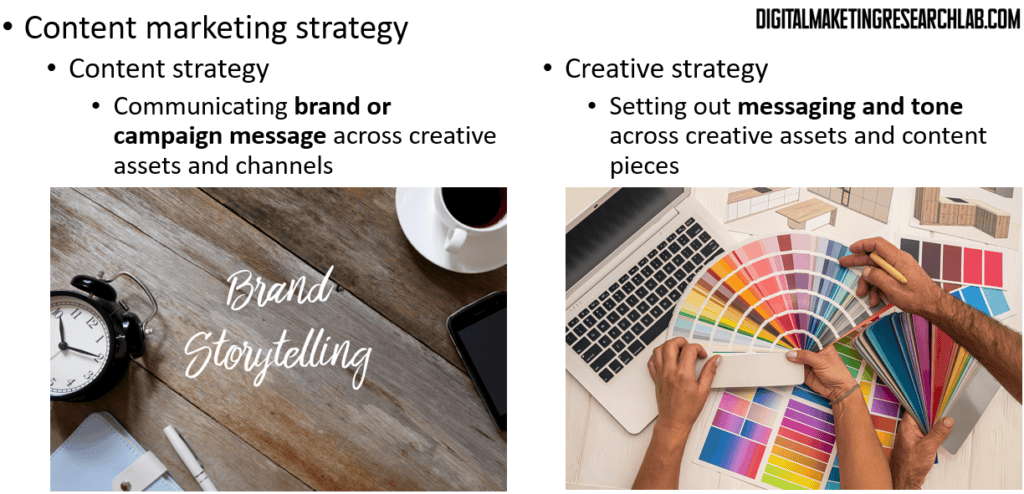
Developing a content marketing plan
Content marketing goals can be divided into several stages of the buyer’s journey. In the awareness stage, the goal is to tell the audience how the brand can solve their problems and drive visibility. In the interest stage, the goal is to inform the audience about what the brand does and how it does it, and to convince them of the brand’s proposition. In the consideration stage, the goal is to convince the audience to choose the brand over competitors. In the conversion stage, the goal is to drive the audience towards e-commerce or lead generation areas of the website or business. And in the retention stage, the goal is to retain existing customers, drive positive affinity, and encourage repeat business.
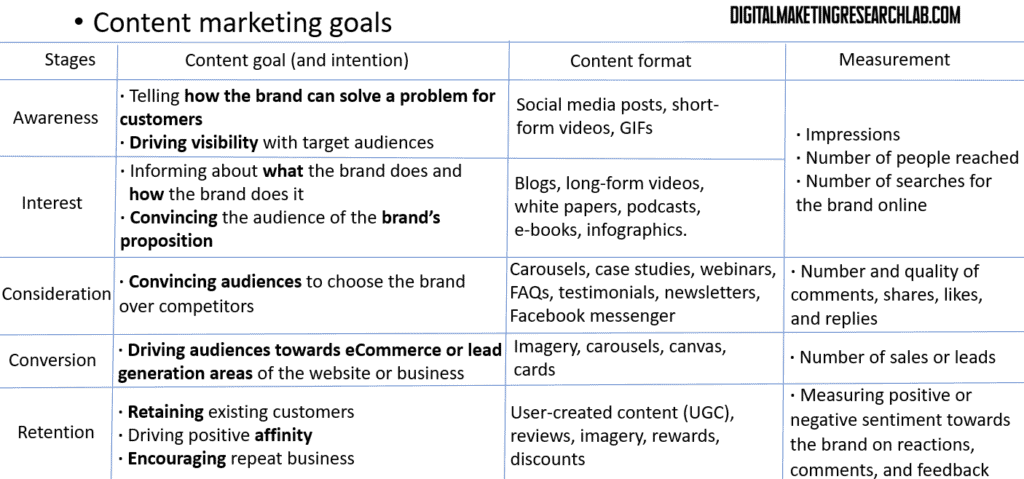
Setting content marketing goals is critical, and these goals need to be aligned with the overall business goals. There are a few key considerations here.
First, there needs to be consistency – the language, appearance, and messaging of the content should be consistent across all pieces, and in line with other marketing materials the business is using. This creates a cohesive brand identity.
Second, the content marketing activities should support and complement other business campaigns the company is running. The content needs to work together with other marketing efforts.
And third, it’s important to get input and ideas from within the business itself. Consulting with different teams and departments can provide valuable insights to shape the content strategy.
By ensuring the content marketing goals are well-aligned with the broader business objectives, and incorporating feedback from internal stakeholders, the content can be optimized to most effectively support the company’s overall growth and success.
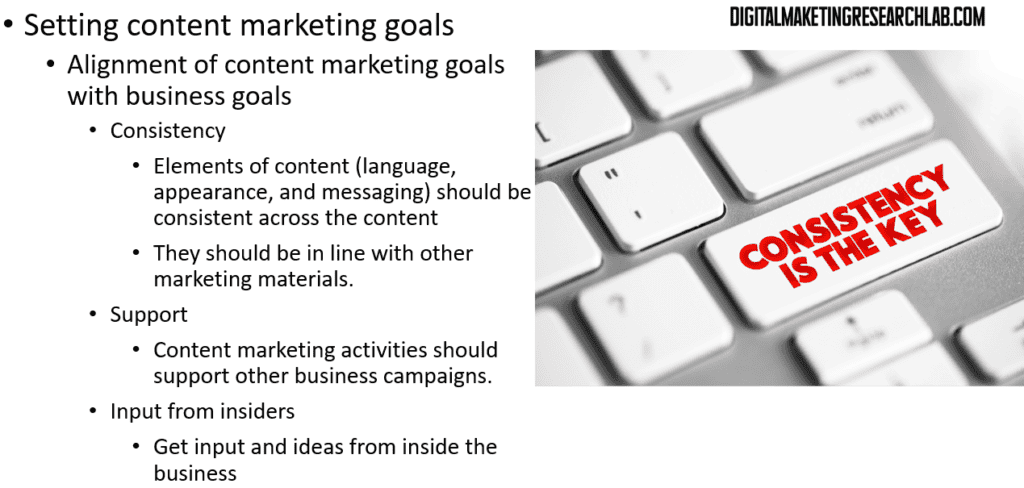
Creating effective buyer personas is an essential part of a content marketing strategy. Buyer personas are imaginary characters that represent the target audience. They are based on customer insights from sources like social, search, and site analytics, and help shape the content strategy by informing the choice of creative and digital formats, platforms and media, and the content needed to meet the needs of prospective customers.
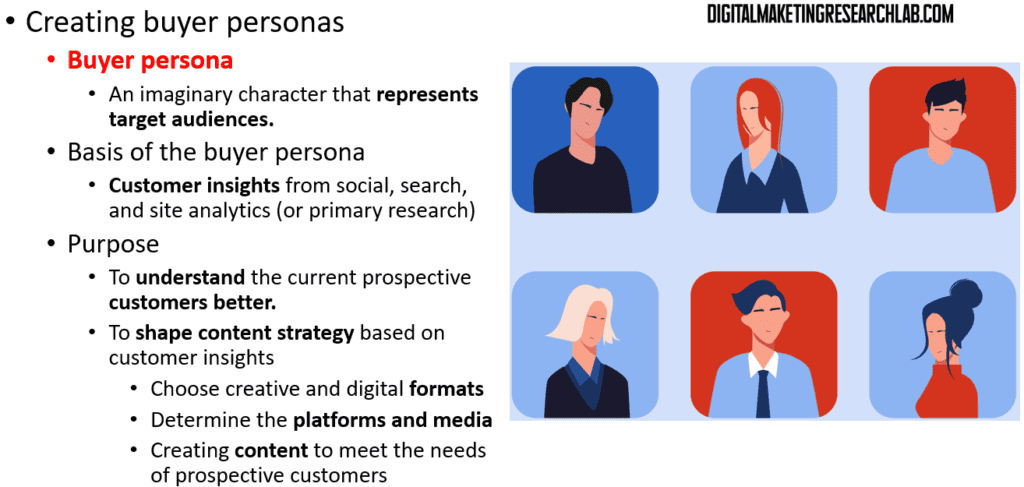
When creating buyer personas, there are several key elements to consider.
On the demographic side, this includes the persona’s name, age, gender, job, and income level.
Geographically, the location of the persona is also an important factor.
In terms of interests, you’ll want to identify the persona’s likes and dislikes, as well as their habits and skills.
Looking at media behavior, you should document which channels they use, such as social media and search engines, as well as their main sources of information, like blogs and webinars.
And when it comes to buyer behavior, you’ll want to understand what stage of the buyer’s journey they are in, whether they are in the awareness, consideration, or conversion stage. Additionally, understand if they are an impulse buyer or someone who takes a more considered approach to purchasing.
By capturing all of these detailed elements about the target buyer persona, the content marketing strategy can be fine-tuned to most effectively reach and resonate with this ideal customer profile.
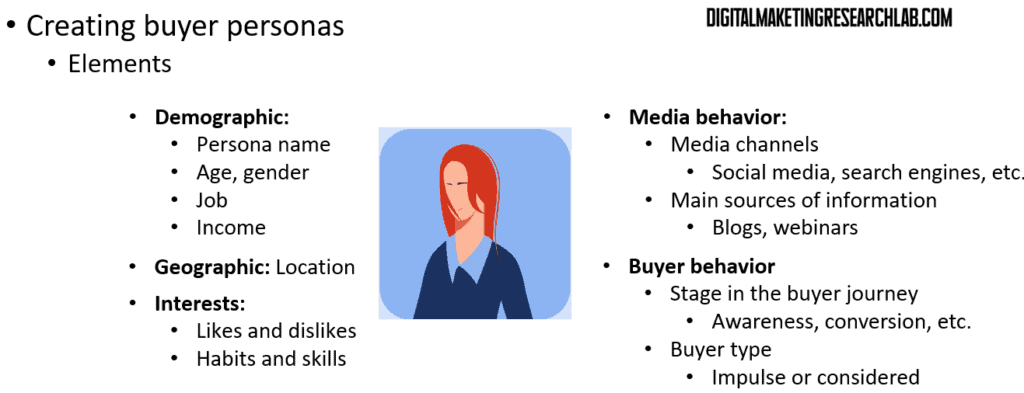
When developing a content marketing plan around buyer personas, there are several key steps to follow.
First, you’ll want to select the personas to focus on, considering both the ease of reaching that audience online as well as the expected value they can provide to the business.
Next, you’ll need to set budgets for the content production process.
Then, you’ll develop the creative messaging and assets, ensuring they are fully aligned with the prospective buyers’ needs and demonstrate how your offering can solve their specific issues.
The fourth step is to select the channels and devices to distribute this content, based on an understanding of the target audience’s media behaviors and the requirements of those particular channels.
Fifth, you’ll create the types of content that are most appropriate for the stages of the purchase journey where your target personas are currently situated.
And finally, you’ll set key performance indicators (KPIs) and timelines to track the engagement and conversion results of your content.
By meticulously working through each of these steps, you can ensure your content marketing strategy is laser-focused on reaching and resonating with your ideal buyer personas.
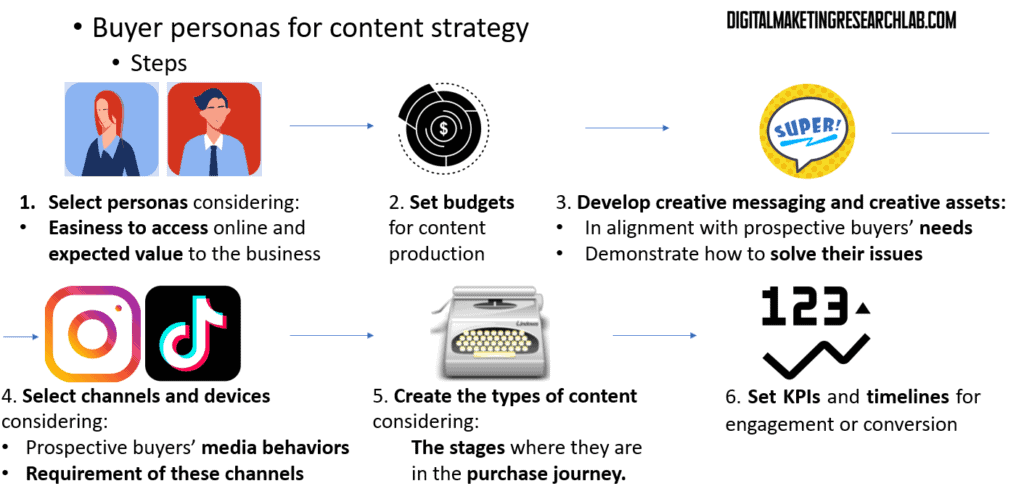
Using content research to find opportunities
Executing the content marketing plan involves several key steps. First, social listening and competitor research can unearth popular content topics. Second, keyword research can discover what people are searching for online. Third, a creative brief can be written to guide the ideas and content creation. Fourth, content themes and topics for production can be decided on. Fifth, the content can be shared across multiple channels like the website and social media. And sixth, engagement metrics can be reviewed to improve performance.
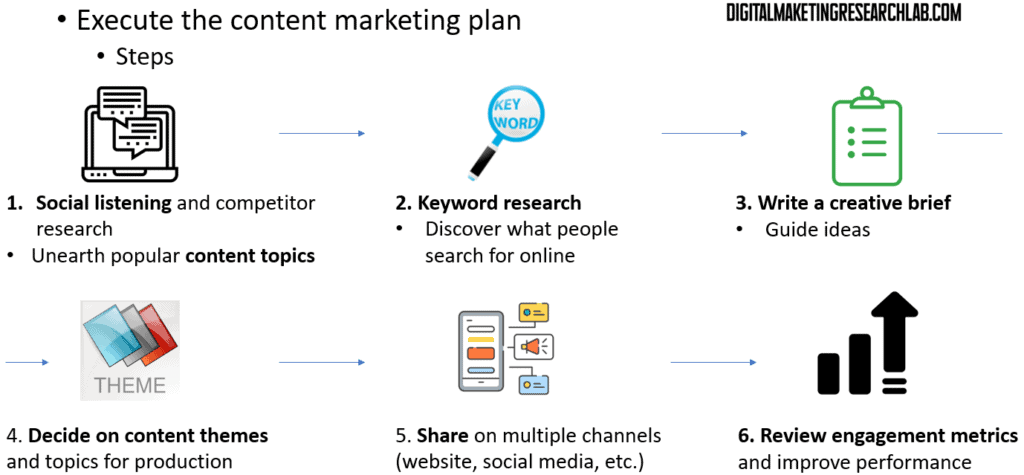
Social listening involves researching what people are saying about a brand and its products. This can provide valuable insights, such as identifying what people are talking about, spotting potential risks, and understanding brand sentiment. These insights then form the basis of a content strategy, by creating content that responds to the findings.
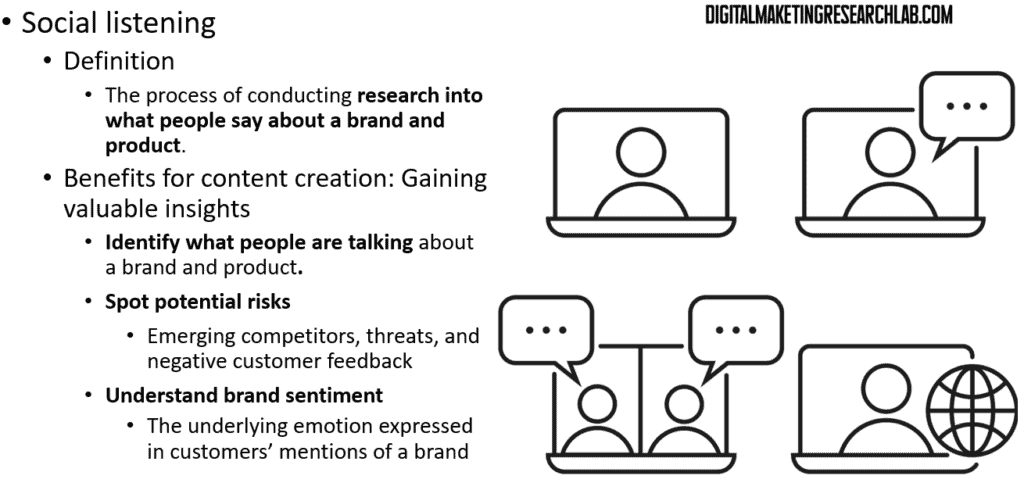
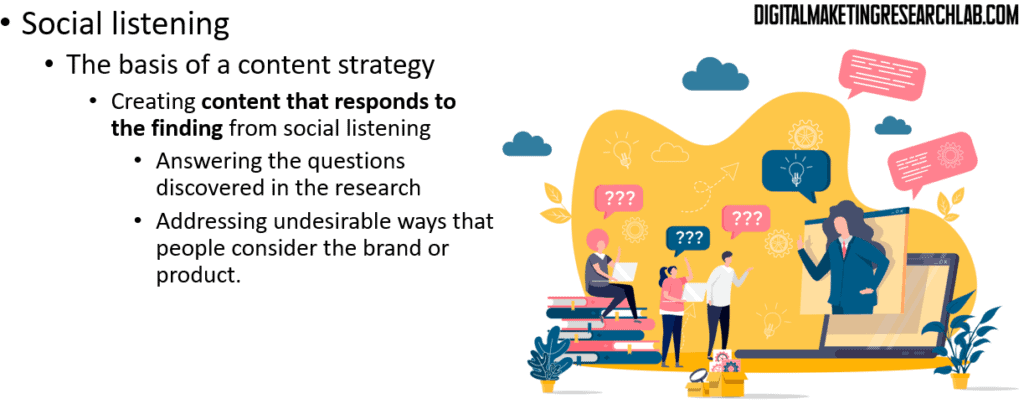
Competitor content analysis involves monitoring and auditing what competitors are doing in terms of their content development schedule, customer feedback, search engine rankings, website optimization, social following, tone of voice, and content formats and channels.
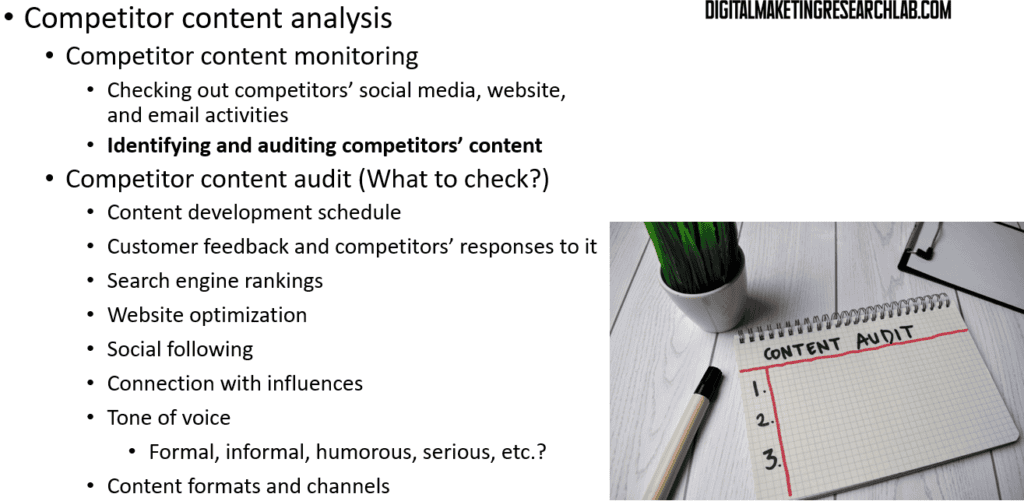
Tools like TweetDeck, SparkToro, Google Alerts, and Fanpage Karma can be used for this purpose.
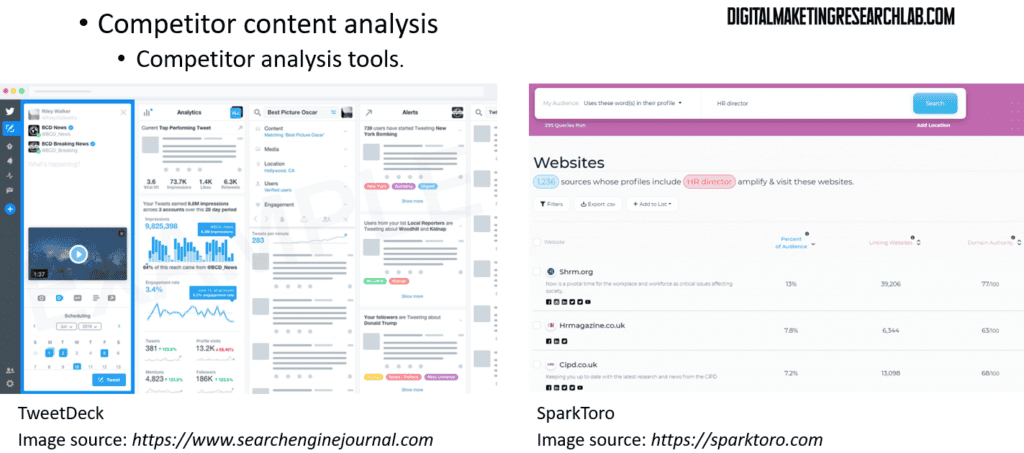
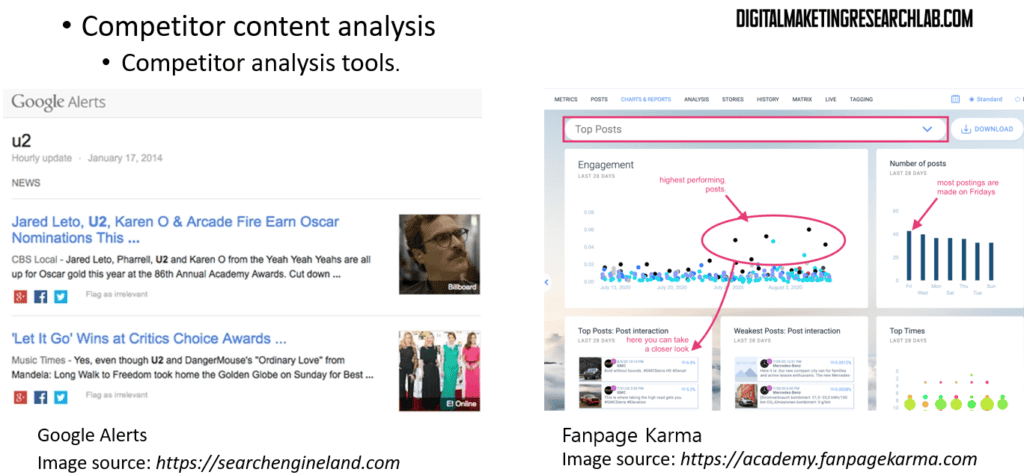
Using content research to find opportunities
Now, let move onto keyword research
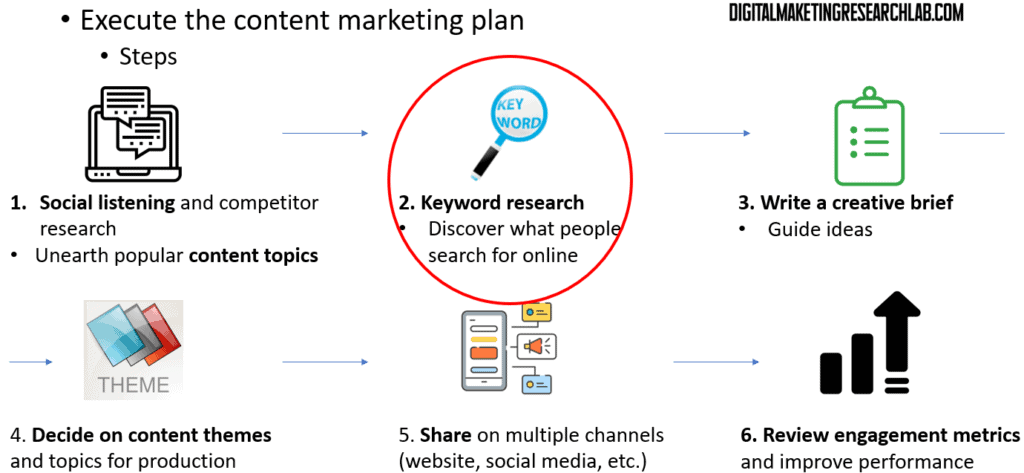
Keyword research is another important step in executing the content marketing plan. It involves looking into the things that customers search for online and the questions they ask search engines. This enables the creation of content that customers are actively looking for, which can pull the right kind of visitors to the website and identify content gaps.
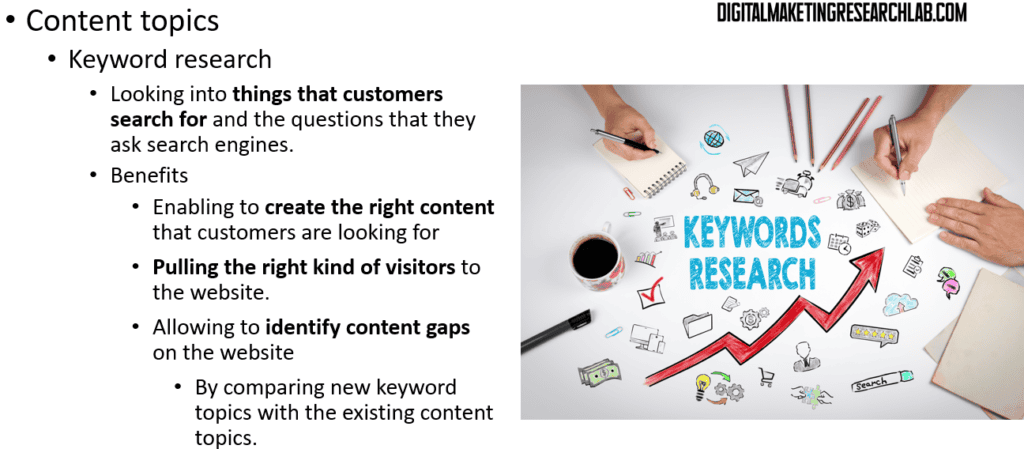
When it comes to finding content topic opportunities, keyword research is a crucial step. Here’s a breakdown of the key steps in the keyword research process:
First, you’ll want to pick a broad topic that you want to create content around.
Next, you’ll brainstorm a list of ideas and keywords related to that topic.
Then, you’ll take those keyword ideas and enter them into an SEO keyword research tool like Ahrefs. This will allow you to find related keywords, as well as data on their search volumes and difficulty scores.
The fourth step is to prioritize those keywords based on how important the topics are to your business and marketing goals.
Finally, you’ll use that prioritized list of keywords to guide the actual content creation, ensuring you’re producing content that aligns with what your target audience is actively searching for online.
By following this systematic keyword research process, you can uncover the best content topic opportunities that will drive valuable traffic and engagement to your business.
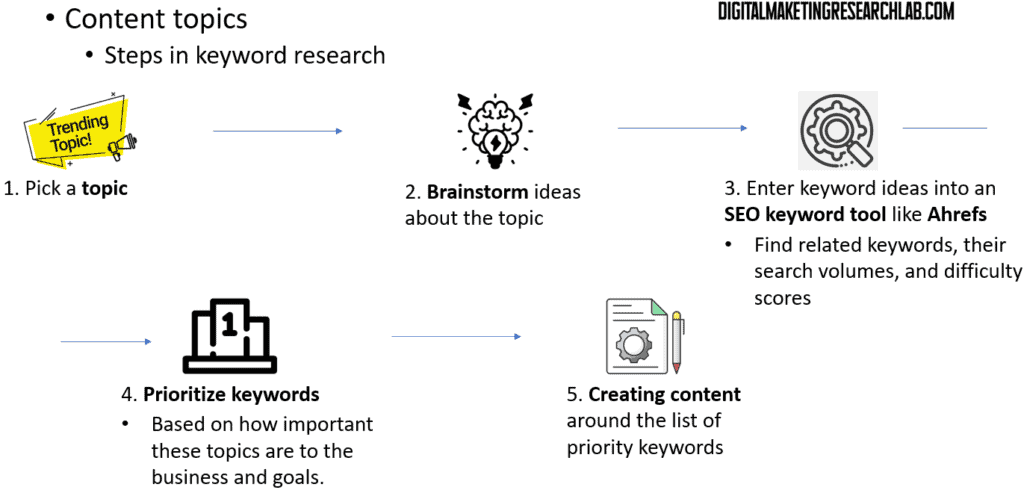
Ok, now let’s move on to ‘writing a creative brief’
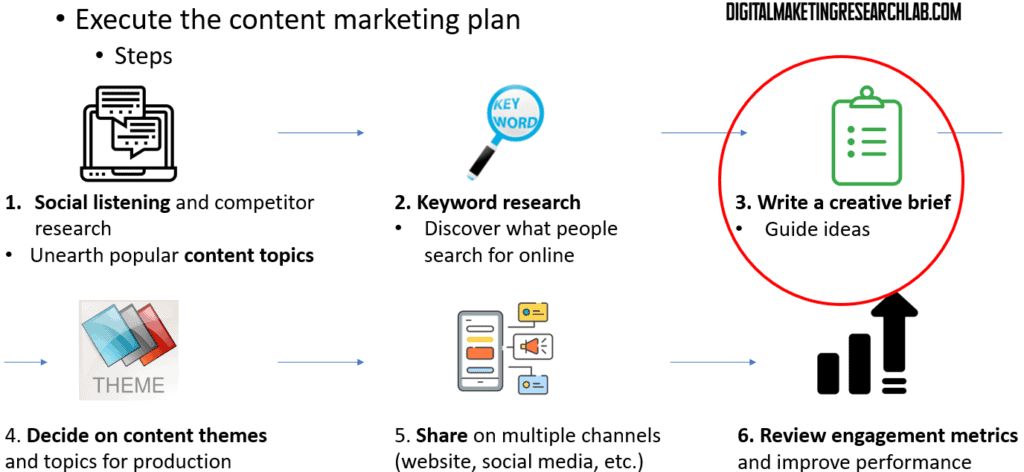
A creative brief is a set of requirements and recommendations that guides content creation. It identifies the most important insights from the research on personas, competitor analysis, and keyword research, and provides usable actions for content development.
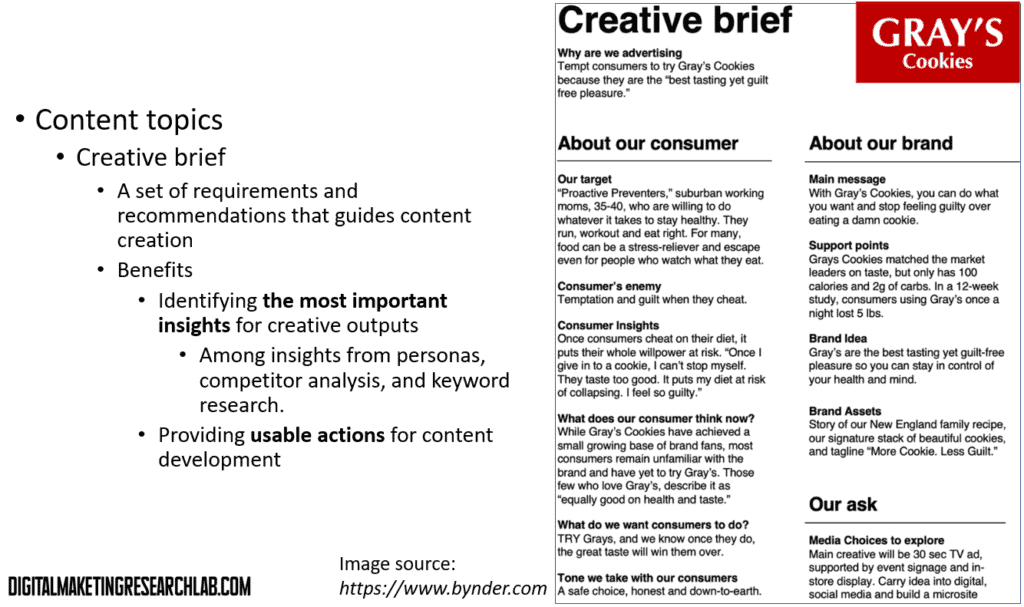
Key considerations include the objectives of the campaign, the buyer personas, the brand personality and story, the required channels and formats, and the budget and deadline.
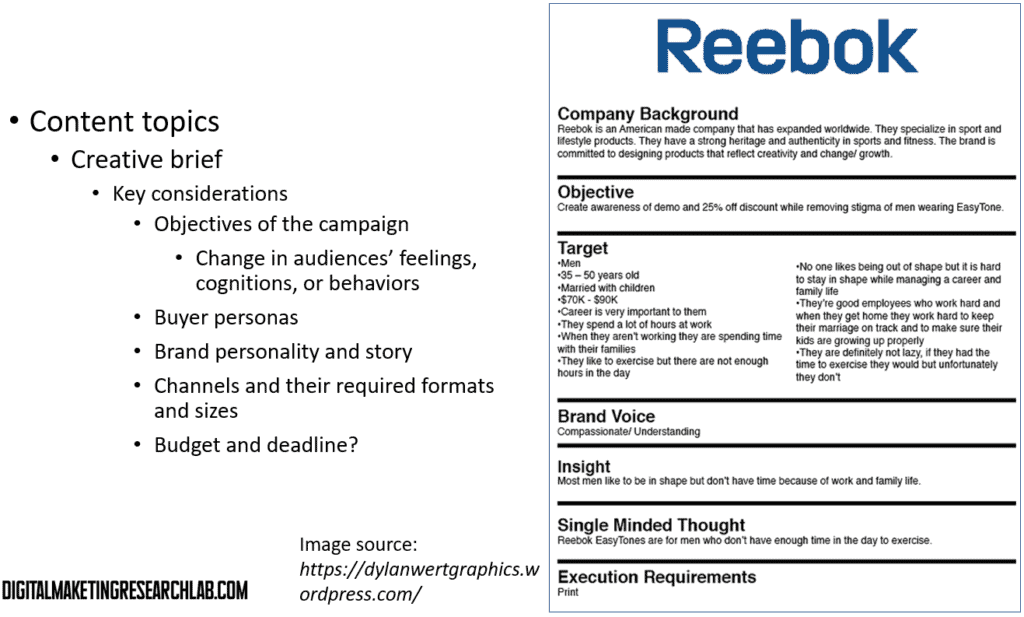
Brand storytelling is the process of communicating engaging and memorable stories about the brand with the target audience. It aims to connect the brand with audiences who share its values, and can improve brand credibility and authenticity, as well as support the brand in times of crisis.
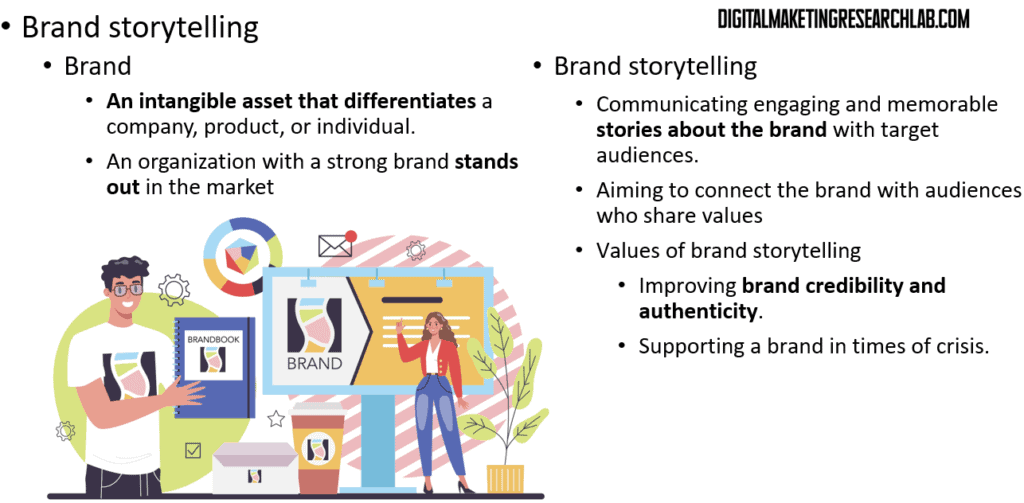
Key steps include knowing the brand and its goals, finding the brand story, identifying the audience’s knowledge level, mapping the story elements to the buyer personas, crafting the story, sharing the story, and engaging with relevant communities.

You can fine checklist for brand stroy below

There are three main categories of content: functional, emotional, and essential. Functional content is fact-based and directly related to the business or brand. Emotional content relates to human experience and shows the brand’s personality. And essential content is the minimum information a consumer needs to know to interact with the business.
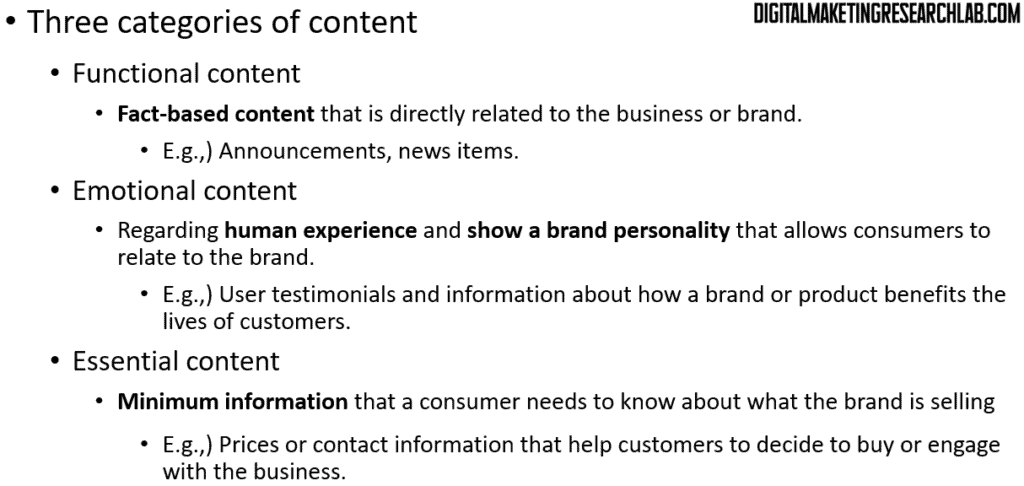
*Reference
Hanlon, A. (2021). Digital marketing: strategic planning & integration. Sage.
Digital Marketing Institute (2021). Introduction to Digital Marketing.